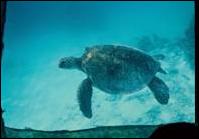Turtles come out of their shell

22 May 2008 – Wellington
Forest & Bird media release for immediate use
Turtles come out of their shell
Most New Zealanders are more familiar with pet turtles in living room aquariums than the large turtles that swim off our coast, but Forest & Bird is asking Kiwis to help protect these fascinating sea creatures on World Turtle Day this Friday (May 23).
World Turtle Day celebrates the endangered creatures and highlights ways to protect them from human threats.
Five species of sea turtle have been recorded in New Zealand waters, with the leatherback the most commonly seen, especially off the West Coast, according to Forest & Bird Conservation Advocate Kirstie Knowles.
The leatherback is the largest turtle in the world – up to three metres long – and the heaviest – up to 900 kilograms – and can dive the deepest – down to 900 metres. It is also critically endangered, according to the International Union for Conservation of Nature (IUCN).
Other sea turtles recorded in New Zealand waters include the loggerhead turtle, the green turtle, the hawksbill turtle and the olive ridley turtle, which are seasonal visitors, mainly in the north.
Sea turtles have been swimming in our oceans for at least 110 million years, but now human activities threaten turtle populations around the world. Threats include entanglement and drowning in fishing gear, eating plastic, habitat disturbance, and killing turtles for their eggs, meat and shells, says Kirstie Knowles.
How New Zealanders can help protect turtles:
• Don't pollute or litter. Pollution makes its
way to sea, poisoning turtles and destroying their habitats.
Always properly dispose of hazardous materials such as paint
or oil. Litter, such as plastic bags, kills many sea
turtles. They sometimes eat plastic, which blocks their
digestion and they starve, or they get tangled in it and
drown.
•
• Organise a beach clean-up. Help make
our seas healthy for sea turtles and other marine life.
Contact your local Forest & Bird branch and get active.
•
• Take care when travelling overseas. If you
are holidaying at an overseas beach, check whether there are
nesting turtles. If so, make sure your accommodation
supports turtle conservation. Steer clear of the beach at
night during the summer. You will frighten nesting sea
turtles back into the sea, stopping them from laying eggs
and jeopardising any eggs they have laid.
•
• Do
not buy or use products made from tortoise shell.
International trade in wild turtle products is banned by all
countries that have signed the Convention on International
Trade in Endangered Species (CITES), including New Zealand.
•
What’s the difference?
Turtles live in the sea, and have flippers and thin, flat shells to make them more buoyant.
Tortoises live on the land, and have legs adapted for walking and thick, round shells to protect them from predators.
Terapins live in fresh water and spend some time on land.
ends


 Gordon Campbell: On The Royal Commission’s Fine-tuning Of Vaccine Mandates And Lockdowns
Gordon Campbell: On The Royal Commission’s Fine-tuning Of Vaccine Mandates And Lockdowns NZDF: Details From Interim Court Of Inquiry Report Into HMNZS Manawanui Incident Released
NZDF: Details From Interim Court Of Inquiry Report Into HMNZS Manawanui Incident Released Land Air Water Aotearoa: Ambitious Nationwide Initiative To Track And Share Actions To Improve Freshwater
Land Air Water Aotearoa: Ambitious Nationwide Initiative To Track And Share Actions To Improve Freshwater NZ Government: Chemical Weapons And Iranian Missiles Targeted In New Russia Sanctions
NZ Government: Chemical Weapons And Iranian Missiles Targeted In New Russia Sanctions Ministry For Culture And Heritage: Reverberations Of Erebus Disaster Still Felt 45 Years Later
Ministry For Culture And Heritage: Reverberations Of Erebus Disaster Still Felt 45 Years Later Watercare Services: No Cause For Concern After Slightly Elevated Levels Of Arsenic Detected In Treated Waikato River Water
Watercare Services: No Cause For Concern After Slightly Elevated Levels Of Arsenic Detected In Treated Waikato River Water Te Pāti Māori: Government’s First Year A ‘Catastrophe For Māori’
Te Pāti Māori: Government’s First Year A ‘Catastrophe For Māori’


